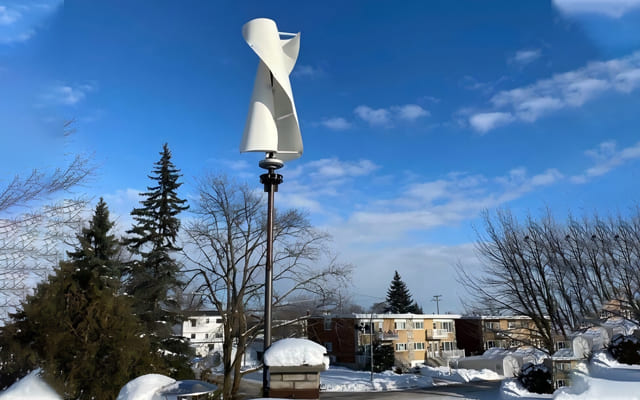🌬️ Introduction
In cold and humid regions, wind turbines face a hidden but serious challenge: blade icing. Ice accumulation on turbine blades can cause performance losses, mechanical stress, and even full shutdowns. For wind farms operating in mountainous or coastal climates, this is not just a seasonal inconvenience—it’s a threat to long-term energy output.
This article explores the causes and consequences of wind turbine blade icing and introduces smart solutions, including how the FS Vertical Axis Wind Turbine by Elege New Energy offers enhanced resilience in icing environments.
🌡️ Why Do Wind Turbine Blades Ice Up?
Blade icing occurs when supercooled water droplets in fog, rain, or clouds come into contact with the cold surface of turbine blades and freeze instantly. Key contributing factors include:
-
Ambient temperature below 0°C
-
Blade surface colder than -5°C
-
Relative humidity over 85%
-
Wind speeds that increase droplet collision
This process disrupts the smooth airflow over the blade, affecting lift and drag forces, and leads to significant power reduction.
❄️ Types of Wind Turbine Blade Icing
Understanding the type of icing helps determine the most effective countermeasures:
| Ice Type | Formation Conditions | Characteristics |
|---|---|---|
| Glaze Ice | 0°C to -5°C, rain/fog | Transparent, dense, adheres tightly |
| Rime Ice | Below -5°C, light fog | White, brittle, less adhesive |
| Mixed Ice | -10°C to -3°C, variable clouds | Semi-hard, layered, commonly seen in hills |
🗻 Terrain and Geographic Risks
Blade icing is not just about weather—it’s also about where the turbine is located. Risk zones include:
-
Mountain ridges and valleys
-
Windward slopes exposed to humid airflow
-
Regions like southwestern China, Canada, and northern Europe
The relative altitude—not just height above sea level—affects icing probability. Turbines located in areas with strong upward airflow and condensation layers are more prone to icing.
⚠️ Effects of Blade Icing on Wind Turbines
Icing reduces turbine efficiency and endangers operation:
-
5–15% drop in power output in light icing
-
Complete shutdowns in heavy icing conditions
-
Increased vibration and fatigue in the drivetrain
-
Delayed recovery times during cold fronts
For wind farms, these issues translate into lost revenue and increased maintenance costs.
🔍 Detecting Blade Icing in Real-Time
Modern wind farms rely on ice detection systems to prevent performance loss:
-
Direct Sensing: Weighing systems or optical cameras on blades
-
Indirect Sensing: Measuring humidity, temperature, power output loss
-
Mathematical Modeling: Predictive analytics based on weather data
-
Blade Vibration Sensors: Detect shifts in blade frequency caused by ice weight
Real-time detection is key to triggering automated anti-icing protocols before power loss becomes critical.
🔧 De-Icing and Anti-Icing Solutions
To combat blade icing, turbines use active or passive technologies:
1. Active Systems
These involve internal heating mechanisms:
-
Hot-air circulation inside blades
-
Heated wires embedded in the blade surface
-
Zonal heating control for energy efficiency
Air heating systems raise the internal temperature of the blade to 60–80°C, keeping the surface just above freezing without damaging structure or paint.
2. Passive Systems
These involve surface treatments:
-
Hydrophobic coatings to reduce water adhesion
-
Nano-structured blade films that minimize freezing contact
-
Best used as supplemental systems
3. Energy Cost Efficiency
-
Anti-icing systems consume less than 3% of turbine output
-
De-icing operations require 3–8%, depending on icing severity
-
Cost-effective compared to lost production or blade damage
-
System cost is usually 5% of total turbine investment
🌟 Featured Solution: FS Vertical Axis Wind Turbine by Elege
At Elege New Energy, we’ve engineered a solution for winter resilience: the FS Vertical Axis Wind Turbine. Designed for both urban rooftops and rural microgrids, the FS series stands out with its:
✅ Low start-up wind speed (<2m/s) – Performs even in weak winter winds
✅ Symmetrical design – Minimizes ice build-up on any one side
✅ Quiet operation – Ideal for homes, schools, or commercial buildings
✅ High torque and low RPM – Reduces stress during ice shedding
✅ Optional heating module – Built-in protection against freezing
❄️ The FS turbine’s vertical axis structure reduces the horizontal spread of ice and maintains balance even under asymmetric icing conditions.
🔗 Learn more: https://elege-energy.com/
✅ Best Practices for Icing Prevention
For wind farms or off-grid installations operating in cold climates:
-
Install zonal blade heating systems that target the outer 30% of the blade
-
Combine passive coatings with active de-icing systems
-
Monitor with real-time vibration sensors
-
Initiate heating after turbine shutdown, not just during operation
-
Choose turbines with cold-weather design, like the Elege FS series
Blade icing is a growing concern for wind turbines in cold, high-altitude, and humid environments. But with advanced detection and de-icing solutions—and smarter turbine design like the FS Vertical Axis Wind Turbine—you can ensure year-round performance, reduce downtime, and extend equipment lifespan.
Looking to upgrade your winter wind energy solution?
Trust Elege. Trust FS.

